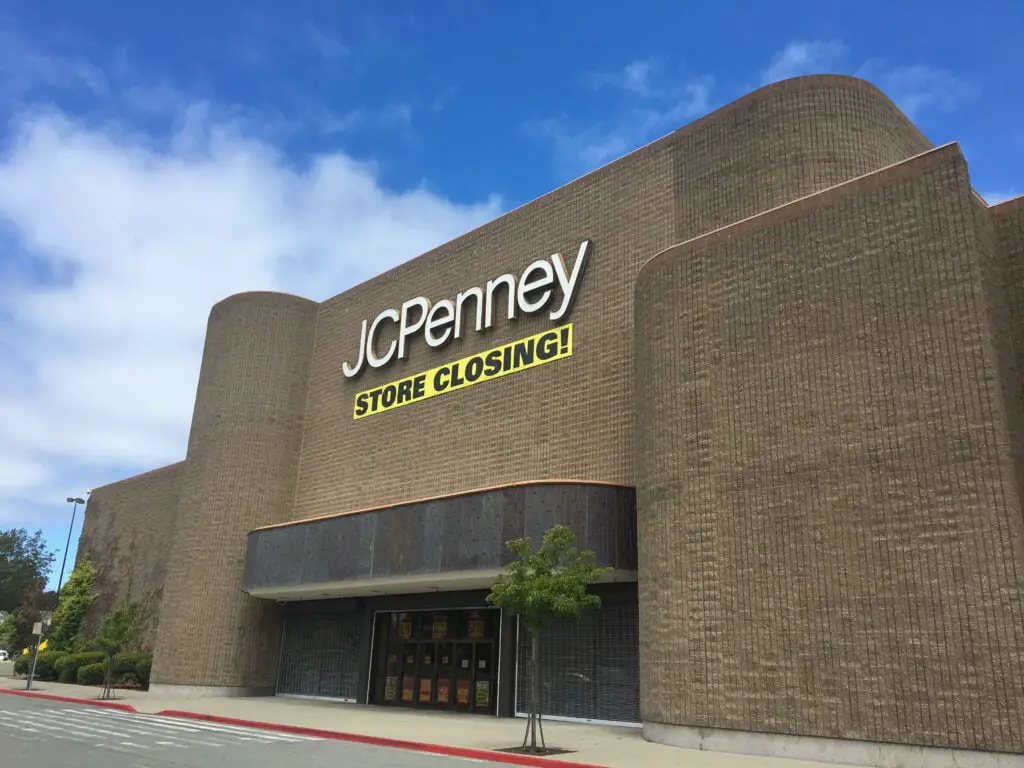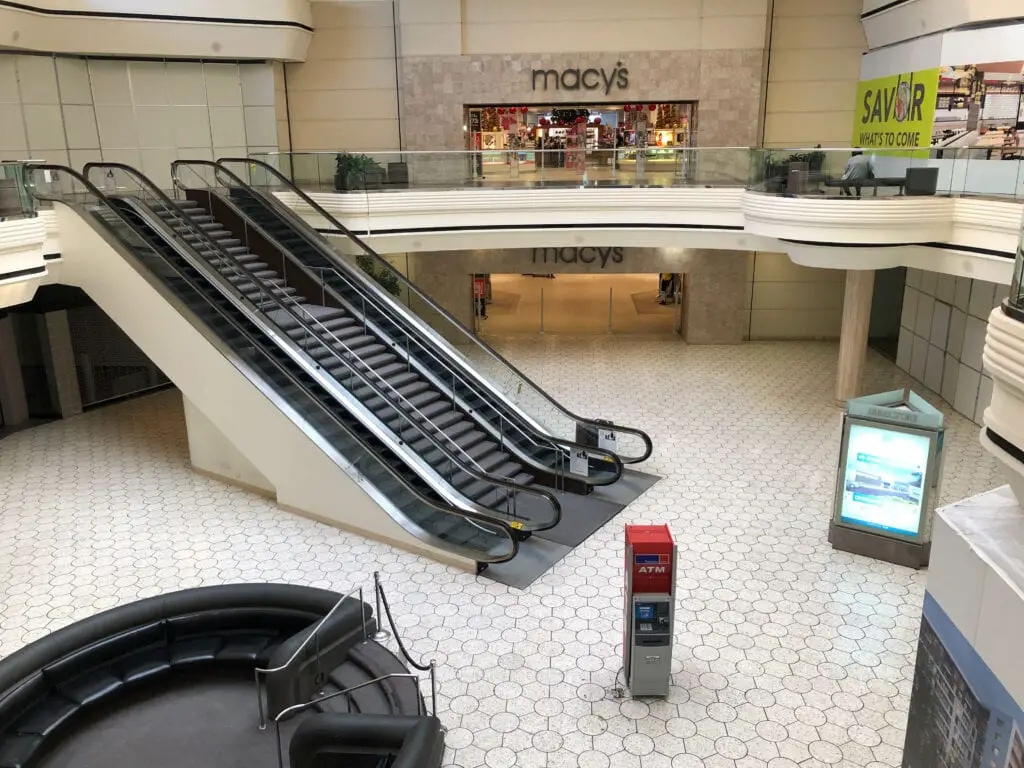The Rise of Hilltop Mall
Hilltop Mall, initially opened on September 2, 1976, marked a significant development in Richmond, California‘s retail landscape.
Developed by the renowned A. Alfred Taubman, this regional shopping center was designed to cater to the diverse needs of the local community, offering a wide range of stores and services across its two floors.
The mall’s opening was a landmark event, symbolizing the growth and modernization of Richmond’s commercial sector.
The original anchor stores of Hilltop Mall were Capwell’s, Macy’s, and JCPenney, each bringing its unique brand and clientele to the mall. With its distinctive red-tiled exterior, Capwell’s was one of the first stores to open, drawing in shoppers with its wide array of merchandise.
JCPenney and Macy’s, already established names in American retail, added to the mall’s appeal, attracting visitors from across the region. The presence of these anchor stores was a testament to the mall’s significance in the local retail market and its potential to become a central shopping destination.
Throughout the years, Hilltop Mall expanded its offerings, incorporating more than 150 stores and services that catered to a wide range of tastes and preferences.
From fashion and electronics to dining and entertainment, the mall became a one-stop destination for things to do in Richmond, California.
However, the success story of Hilltop Mall had its challenges. As the retail industry evolved and consumer habits changed, the mall faced the daunting task of adapting to new trends and expectations.
Despite these challenges, the early years of Hilltop Mall showcased the potential of retail developments to transform local economies and provide communities with valuable services and amenities.
The foundation laid by A. Alfred Taubman and the initial anchor stores played a crucial role in shaping the mall’s identity and legacy in Richmond’s commercial history.
Architectural Features and Layout of Hilltop Mall
The architectural design and layout of Hilltop Mall played a crucial role in its initial success and enduring appeal. Designed with a focus on accessibility and aesthetic appeal, the mall’s structure aimed to provide a comfortable and engaging shopping experience for visitors.
The layout was characterized by two intersecting hallways aligned with the cardinal directions, creating a cross-shaped floor plan that allowed for easy navigation and flow of foot traffic.
At the heart of Hilltop Mall was the Rotunda, an architectural feature that became synonymous with the mall’s identity.
This central area, marked by its open space and natural lighting, featured a distinctive spiral ramp and a central fountain, creating a focal point for visitors and a popular meeting spot.
Above the fountain, the Solar Cantata, a striking gold-anodized aluminum sculpture created by artist Charles O. Perry in 1971, added an artistic element to the mall’s design, reflecting the era’s interest in integrating art into public spaces.

The mall’s exterior and interior were designed to complement each other, with the exterior featuring ample parking spaces and easy access from major roads, making it convenient for shoppers to visit.
The mall boasted wide corridors, comfortable seating areas, and lush greenery, creating a pleasant shopping environment. The design also included large, well-placed signs and directories to help visitors locate stores, services, and amenities.
The anchor stores, strategically located at each end of the cross-shaped layout, were key attractions that drew visitors through the mall, encouraging foot traffic past smaller stores and kiosks.
This layout was typical of the period’s mall design, aiming to maximize exposure for all retailers while providing shoppers with various shopping experiences.
Over the years, the design of Hilltop Mall, particularly the iconic Rotunda, remained a beloved feature, even as the mall faced economic challenges.
The design of Hilltop Mall, with its unique features and thoughtful layout, played an essential role in its history and in the memories of those who visited it.
Decline and Challenges
Hilltop Mall began facing significant challenges by the late 1990s and early 2000s. Major anchor stores, the backbone of the mall’s success, started to need help.
In 1996, the Emporium closed its doors, leaving a large vacancy that needed to be filled. This was a significant blow to the mall, as anchor stores traditionally draw considerable foot traffic.
2012 Hilltop Mall faced significant financial challenges, leading to a loan default. The financial troubles culminated in the property’s foreclosure in June 2013.
Despite these challenges, Jones Lang LaSalle was retained to continue managing the property post-foreclosure, indicating a level of trust in their ability to navigate the mall through its financial and operational difficulties.

In 2017, JCPenney, one of the original anchor tenants, announced it would close its Hilltop Mall location as part of a nationwide plan to shut down underperforming stores.
This closure marked the end of an era and left another large space empty. The departure of JCPenney was a clear sign of the mall’s declining appeal and the changing landscape of retail shopping.
On February 6, 2020, it was announced that the Sears store at Hilltop Mall would be closing, marking the end of an era for one of the mall’s key retail anchors.
This closure was part of a broader strategy by the Sears chain to shut down several stores nationwide in response to financial challenges. The store officially closed its doors in April 2020.
Shortly after that, the COVID-19 pandemic led to widespread temporary closures of retail spaces, significantly impacting Hilltop Mall.
By mid-March 2020, almost all the stores within the mall had closed their doors to the public to comply with health and safety regulations, with Walmart being the notable exception that remained open during this period.
The mall’s physical condition also began to deteriorate, with outdated facilities and a lack of modern amenities that failed to meet the evolving expectations of shoppers.
Safety concerns and a perceived increase in crime contributed to decreased visitor numbers, further exacerbating the mall’s problems.
These factors combined to create a cycle of decline, with fewer stores and shoppers leading to reduced revenues and investment, which in turn led to further decreases in attractiveness and safety.

Attempts at Revitalization
In the early 2000s, efforts were made to revitalize Hilltop Mall in response to its challenges. The ownership changes were a significant part of these efforts.
In 1998, the GM Pension Trust took over full ownership, retaining Taubman Centers as the manager. This change aimed to bring new life and strategies to the mall’s operations.
However, the real shift came in 2007 when Simon Property Group, a well-known retail and real estate name, acquired Hilltop Mall.
This acquisition was part of a larger deal that included other properties, signaling a potential turnaround for the struggling mall.
Simon Property Group’s ownership brought new ideas and strategies for revitalization. They aimed to modernize the mall, attract new tenants, and improve the shopping experience.
Despite these efforts, significant challenges remained. The rise of online shopping and changing consumer habits continued to impact foot traffic and sales. Additionally, the economic downturns and shifts in the retail industry posed further obstacles to the mall’s revival.
In 2017, the mall was rebranded as “The Shops at Hilltop,” accompanied by interior and exterior renovation plans. The goal was to create a more modern and appealing shopping environment to attract a broader range of tenants and customers.
New dining options, entertainment facilities, and retail stores were part of the planned improvements to enhance the mall’s appeal.
The Transformation into Hilltop by the Bay
The most ambitious plan for Hilltop Mall’s transformation emerged in the late 2010s, with the proposal of “Hilltop by the Bay.”
This plan envisioned a complete mall overhaul into a mixed-use development incorporating retail, residential, and entertainment spaces.
The idea was to create a self-contained community where people could live, work, and play, reflecting a growing trend in urban development.

In 2017, LBG Real Estate Companies and Aviva Investors acquired the property to turn the area into a vibrant mixed-use space.
They planned to introduce new elements such as a 99 Ranch Market, various dining options, and entertainment venues to attract diverse visitors and residents.
The project aimed to not only revitalize the mall but also to contribute to the broader development of the Richmond area.
However, the transformation faced significant hurdles. The COVID-19 pandemic, which began in early 2020, profoundly impacted retail and real estate, halting progress and changing the landscape of consumer behavior.
Despite these challenges, the vision for Hilltop by the Bay remained, with the developers and the city hoping to resume the project as conditions improved.
The plan for Hilltop by the Bay represents a hopeful future for the site, aiming to turn the once-thriving mall into a new hub of activity and community life in Richmond.
The Future of Hilltop
The future of Hilltop Mall, now under the new ownership of Prologis since early 2021, is steering toward a different direction than its original retail-centric model.
Prologis, recognized as a global leader in logistics real estate, has announced plans to transform the site into a mixed-use development that includes residential, retail, and modern logistics facilities.
This new vision aims to adapt to the changing consumer and business needs landscape, creating a space fostering community, commerce, and connectivity.
The transition from a traditional mall to a mixed-use development reflects broader trends in urban planning and real estate, responding to the increasing demand for versatile spaces that serve multiple purposes.
The potential for job growth, economic opportunity, and revitalization of the area remains high. The city of Richmond and its residents are watching closely, hopeful that this new phase will bring positive changes to the community.

The transformation requires careful planning, significant investment, and collaboration between Prologis, the city, and the community.
Ensuring that the development meets the needs and expectations of Richmond’s diverse population will be crucial for its success. As the project unfolds, the community awaits the revival of the once-bustling shopping center.
Hilltop Horizon Specific Plan
The Hilltop Horizon Specific Plan represents a significant shift in the development strategy surrounding the former Hilltop Mall.
The City of Richmond is spearheading this ambitious project, focusing on transforming the approximately 143-acre site into a vibrant, mixed-use destination.
This area, once dominated by the auto-oriented retail center, is poised to become a higher-intensity hub combining residential, commercial, and recreational spaces.
The Specific Plan is designed to align with the city’s General Plan, aiming to revitalize the region by attracting new businesses, residents, and investments.
The goal is to create a “shovel-ready” framework that will facilitate the seamless development of the area after the adoption of the Specific Plan and environmental documentation.
This plan is about changing the physical landscape and fostering a community-oriented environment that meets the diverse needs of Richmond’s population.
Community engagement is at the heart of the Hilltop Horizon project. The city has proactively involved residents, businesses, and stakeholders in planning, ensuring the redevelopment reflects the community’s vision and priorities.
Through workshops, surveys, and public meetings, the city has gathered valuable input shaping the Hilltop area’s future. This collaborative approach aims to ensure that the final plan is well-informed and supported by those it will impact the most.
The transformation envisioned by the Hilltop Horizon Specific Plan is a testament to Richmond’s commitment to sustainable and inclusive urban development.
By reimagining the use of this large tract of land, the city is setting a precedent for how communities can adapt to changing economic landscapes and create spaces that cater to the evolving needs of their residents.
The Hilltop Horizon project is more than just a redevelopment plan; it’s a blueprint for the future of Richmond, promising a revitalized area that offers a range of opportunities for living, working, and leisure.

I hope Hilltop Mall in Richmond can be a family place once again .
Absolutely, bringing back the family vibe to Hilltop Mall sounds wonderful. The vision for its redevelopment, including housing and new retail opportunities, could breathe new life into the area, making it a bustling hub once again for residents and visitors alike.